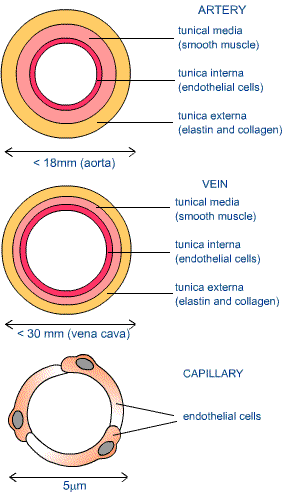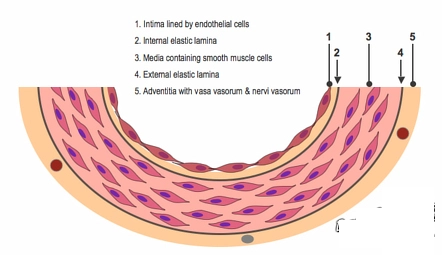Blood vessel
Histology of blood vessels
Blood vessels, namely arteries and veins, are composed of endothelial cells, smooth muscle cells and extracellular matrix (including collagen and elastin). These are arranged into three concentric layers (or tunicae = coat): intima, media and adventitia.
Endothelium
Vascular Endothelium is a simple squamous epithelium.It consists of endothelial cells.
Functions of endothelium
- Release of von willevrand factor
- Release of nitric oxide
- Release of endothelin , angiotensin converting enzyme
- Release of endothelial derived relaxing factor
- Synthesis of type IV collagen
- Hormone synthesis
The intima (or tunica intima)
The tunica intima is the innermost layer. It consists of endothelium resting on subendothelial connective tissue. The thickness and composition of this subendothelial layer varies depending on the type and size of vessel.it is composed of a single layer of endothelial cells and a small amount of subendothelial connective tissue.It is separated from the media by a dense elastic membrane called the internal elastic lamina.
- Endothelium
- Subendothelial connective tissue
- Internal elastic membrane
The media (or tunica media)
The tunica media is the middle layer. It consists of layers of circularly or obliquely-arranged smooth muscle cells with variable amounts of elastin, collagen, and ground substance interposed.It is sandwiched between the intima and adventitia and is the thickest layer.It provides structural support, vasoreactivity and elasticity.It is composed of smooth muscle cells, elastic fibres and connective tissue, which vary in amount depending on the type of vessel.smooth muscle cells contract (vasoconstriction) or relax (vasodilatation), which is controlled by autonomic nerves (nervi vasorum) and local metabolic factors.Elastic fibres allow the vessel to expand with systole and contract with diastole, thereby propelling blood forward.the media is separated from the adventitia by a dense elastic membrane called the external elastic lamina.
The adventitia (or tunica adventitia)
The tunica adventitia is the outer layer. It is composed primarily of connective tissue consisting primarily of collagen fibers and variable amounts of elastic fibers. The tunica adventitia of large arteries and veins also contains blood vessels (the vasa vasorum) and autonomic nerves (the nervi vascularis).The intima and inner part of the media are nourished by diffusion of oxygen and nutrients from blood in the lumen, and the adventitia and outer part of the media are nourished by vasa vasorum.
- Vasa vasorum : supplies blood to vessel wall
- Nervi vasorum : unmyelinated postganglionic sympathetic nerve fibres that release noerepinephirne and cause vasoconstriction
ARTERIES
The walls of arteries are thicker than that of veins to withstand pulsatile flow and higher blood pressures. As arteries become smaller, wall thickness gradually decreases but the ratio of wall thickness to lumen diameter increases (i.e. relative lumen size decreases).
Arteries are divided into three types according to size and function. The constituents of the media of these vessels differ in their relative amounts accordingly.
large elastic arteries :(aorta, large aortic branches [e.g. innominate, subclavian, common carotids, iliacs] and pulmonary arteries): the media is abundant in elastic fibres that allow it to expand with systole and recoil during diastole, thereby propelling blood forward.
medium-sized muscular arteries : (other aortic branches, e.g. coronary and renal arteries): the media is abundant in smooth muscle cells that vasoconstrict or vasodilate, thereby controlling lumen diameter and regional blood flow.
small arteries and arterioles : (in the substance of organs and tissues): the media is abundant in smooth muscle cells that vasoconstrict or vasodilate; in vessels of this size, smooth muscle contraction causes dramatic changes in lumen diameter, thereby controlling systemic blood pressure as well as regional blood flow.
Capillaries
Capillaries are classified in to three groups:
- continuous capillaries
- Fenestrated capillaries
- Sinusoid or sinusoidal capillaries






Discussion